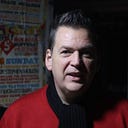Member-only story
Paul Bacon: The Man Behind ‘The Big Book Look’
Have you ever picked up a book and been immediately drawn in by its cover? Chances are, you’ve held a Paul Bacon design without knowing it. This unsung hero of the publishing world revolutionised book jacket design, creating what became known as “The Big Book Look.”
From Marine to Master Designer
Born on Christmas Day, 1923, only 100 yards from Sing Sing Prison in Ossining, NY, Paul Bacon’s journey to becoming a design legend was anything but conventional. After serving in the Marines during World War II, Bacon set his sights on becoming a painter. Little did he know that a friend’s request to illustrate a book about chimps in Africa would put him on an entirely different path.
That book, “The Chimp on my Shoulder,” published in 1951, marked Bacon’s accidental entry into the world of book design. It was authored by Bill Westley, a father Bacon’s friend, who said, ‘You’re an artist you do the cover.’ Bacon had fallen into a new career.
Jazz, Typography, and a New Era of Design
Bacon’s early career was a blend of design and music. He worked at the Hal Zamboni design studio in New York City while moonlighting as a jazz critic for Record Changer magazine. This musical influence would later shine through in his album cover designs for jazz legends like Thelonious Monk and Dizzy Gillespie.
